The Medieval Mason
Today, we meet a medieval mason. The University of Houston's College of Engineering presents this series about the machines that make our civilization run, and the people whose ingenuity created them.
It's hard to say too much about Gothic cathedrals. Incredible size combined with a delicacy of balance and detail that you must see to believe. The spire of Strasbourg Cathedral is 466 feet tall, almost as high as the Washington Monument. Not until the late nineteenth century did Europe erect anything taller.
Gothic architecture suddenly appeared in the middle of the twelfth century, and it kept evolving for 250 years. Then it abruptly stopped developing toward the end of the 14th century.
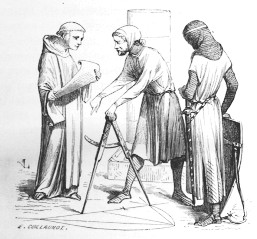 The people who created this art weren't formally educated. In the early days, only forty percent of master masons could even write their name on a document. They weren't trained in formal geometry, and it's unlikely they made any calculations. They didn't know Euclid, but they worked magic with a compass and square.
The people who created this art weren't formally educated. In the early days, only forty percent of master masons could even write their name on a document. They weren't trained in formal geometry, and it's unlikely they made any calculations. They didn't know Euclid, but they worked magic with a compass and square.
Medieval cathedral builders learned their empirical art through apprenticeship. Master builders held all kinds of jealously guarded tricks of the trade -- a vast inventory of knowledge about material selection, personnel management, geometrical proportioning, load distribution, design, liturgy, and Christian tradition.
And make no mistake, those masons saw no clear boundary between things material and things spiritual. Their art flowed from their right brain. It was visual and spatial. They levitated tons of stone into the air to communicate their praise of God, and when they were finished, they embellished the nooks and crannies and high aeries of their buildings with the phantoms of their minds -- with cherubs and gargoyles and wild caricatures of one another.
Of course, working on such a titanic scale in the highest technology of the age, they grew increasingly wealthy, powerful, and proud. They signed their work boldly and dramatically. A twenty-five foot long inscription on the south transept of Notre-Dame Cathedral says:
Master Jean de Chelles commenced this work for the Glory of the Mother of Christ on the second of the Ides of the month of February, 1258.
Even the contemplative labyrinths on cathedral floors led the faithful to a central plaque where they found, not a holy symbol or a saint, but an image of the master mason wielding a compass.
So what became of this marvelous Gothic art? It died out as master builders became educated gentlemen -- when they moved into an office and managed the work of others at a distance. The kind of hands-on creativity that'd driven it so powerfully dried up.
And yet, the last Gothic cathedral was made right here in the United States. Washington DC's National Cathedral was built with great fidelity to both the style and the working spirit of the High Middle Ages. It took most of the twentieth century, but this huge structure was finally finished after 82 years of work, and it is breathtaking. Next time you're in Washington, leave the crowds in the mall, and make a side trip to see it.
I'm John Lienhard, at the University of Houston, where we're interested in the way inventive minds work.
(Theme music)
Gimpel, J., The Medieval Machine: The Industrial Revolution of the Middle Ages. New York: Penguin Books, 1976. See esp., Chapt. 6.
For more on the medieval mason, see Episode 528. For more on medieval cathedrals see Episodes 228, 439, 825, 942, 958. This is a greatly revised version of Episode 97.
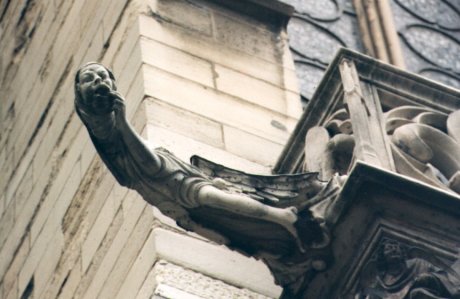
Typical Medieval Gargoyle (from the Sainte-Chapelle, Paris)
Photo by John Lienhard
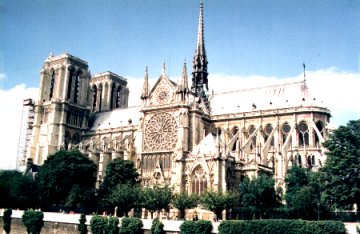
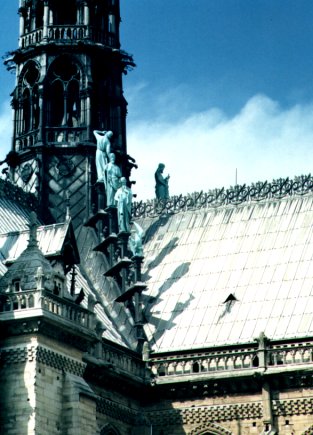
Notre-Dame Cathedral, Paris and a detail of Angel Musicians on its Roof
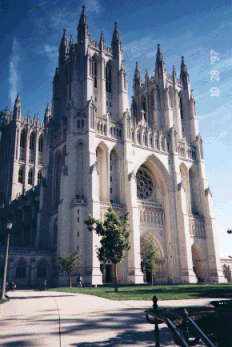
The West Entrance to the National Cathedral in Washington, DC
Photo by Judy Myers, with permission
The image in the text is from Dictionnaire Raisonné de L'Architecture, MDCCCLXVIII, courtesy of the UH Art and Architecture library.